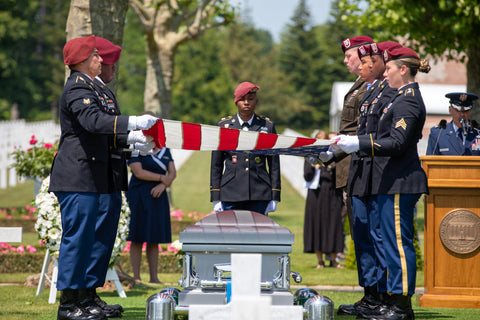
More Than 100 Years After His Death, This Doughboy Finally Receives A Proper Burial
After 105 years, the remains of an American doughboy received a proper burial.
Today, the American Battle Monuments Commission, alongside French and U.S. officials, interred its first Great War unknown since 1988 and the first burial at Oise-Aisne American Cemetery in France since 1932.
On February 8, 2022, a local undertaker, Jean-Paul Feval was digging a fresh gravesite in the cemetery at Villers-Sur-Fère, in northeastern France, when he stumbled upon “human bones, along with artifacts that would later include pieces of a helmet, a stretcher, a trench knife and a corroded, unreadable dog tag,” writes The Washington Post.
The discovery of the stretcher is unique.
“During the fighting they tried to get rid of the bodies as soon as they could,” Caloud told The Post. “They would roll them up in ponchos. They’d roll them up in blankets. They could carry them on stretchers.”
“My guess is he was dead, and what was left of him was put on a stretcher,” he continued.
For the past year French and American officials have worked in tandem to verify beyond a reasonable doubt that the remains found were, in fact, American.
While the identity of the American soldier remains unknown, it was determined that he was killed in July 1918 around the fight for Villers-Sur-Fère.
According to Mike Knapp, the commission’s director of historical services, the “archeological artifacts gave a good indication” that this was the gravesite of an American soldier, however, the Graves Registration Service maps created in 1919-1920, now housed at the National Archives, helped to verify the location of the American cemeteries from the Great War.
“He’s been by himself for over 100 years, and finally we can give him the dignified and honored burial that he rates,” said Bert Caloud, the Oise-Aisne American Cemetery’s superintendent.
Buried with a Purple Heart and given full military honors, the unknown soldier joins where 6,012 of his comrades — 597 unknowns — already rest.
His gravesite reads: “Here Rests In Honored Glory An American Soldier Known But to God.”
The ABMC, which was started in 1923 by President Warren Harding to honor U.S. World War I dead overseas, “operates 26 cemeteries on foreign soil where 123,000 service members from World Wars I and II are buried, and thousands of others are memorialized,” according to The Post.
The soldier’s discovery “is an extraordinarily big deal,” said Knapp.
“Here we are … 105 years after this guy died and … he’s getting a full honors, military funeral just like some veteran would get today at Arlington” cemetery, Knapp continued “I think that says a great deal.”
The Battle
While the First World War would end in just under five months, the fight remained bitter to the last.
In late July 1918, the U.S. Army's 42nd Infantry Division — called the Rainbow Division because it contained outfits from across the country — went on its first offensive, pushing back German forces around the Ourcq River, less than a mile north of Villers-sur-Fère.
The men of that division saw intense action around the village, with Francis Duffy, the division chaplain, writing in his postwar memoir, "Father Duffy's Story," that “Nearly one-third of those who lost their lives in this action received their death wounds from shell fire in and around Villers-sur-Fère."
While it is believed that the unknown soldier was from the Rainbow Division, he could well have been a part of the the 165th Infantry Regiment, which also saw intense action around the French village of Villers-sur-Fère. More than 30 Americans from that regiment hastily buried by a stone wall near the village cemetery.
However, regardless of the fact that “We do not know his name, his age, or his background,"Gen. James C. McConville, Chief of Staff, U.S. Army, told the crowd gathered at Oise-Aisne this morning, "we do know one thing for certain… this soldier was a hero.”
historynet magazines
Our 9 best-selling history titles feature in-depth storytelling and iconic imagery to engage and inform on the people, the wars, and the events that shaped America and the world.
